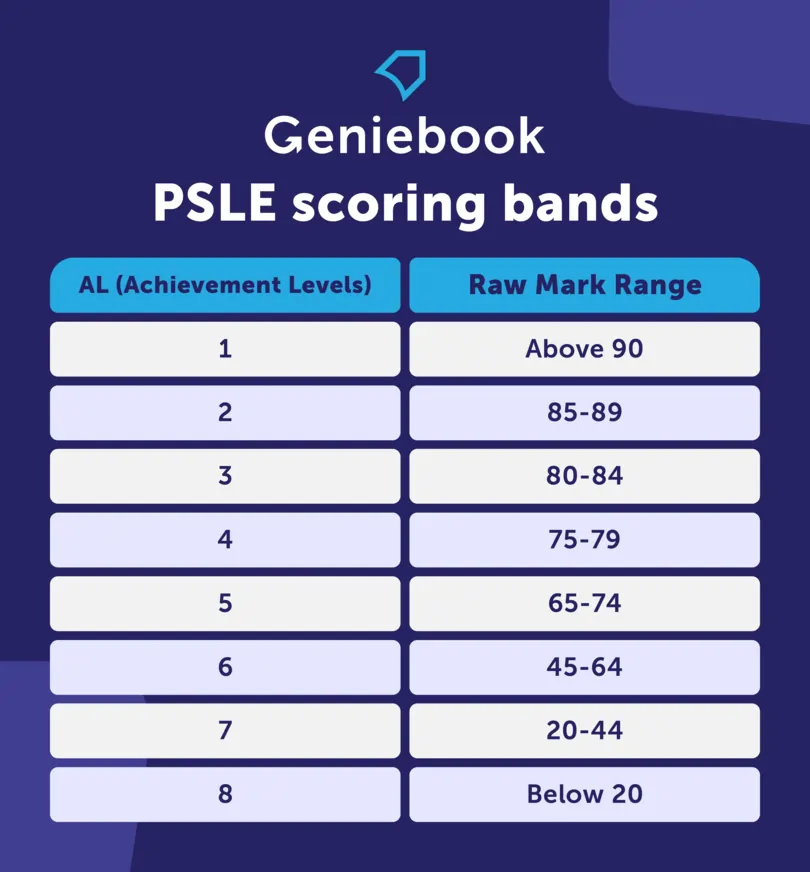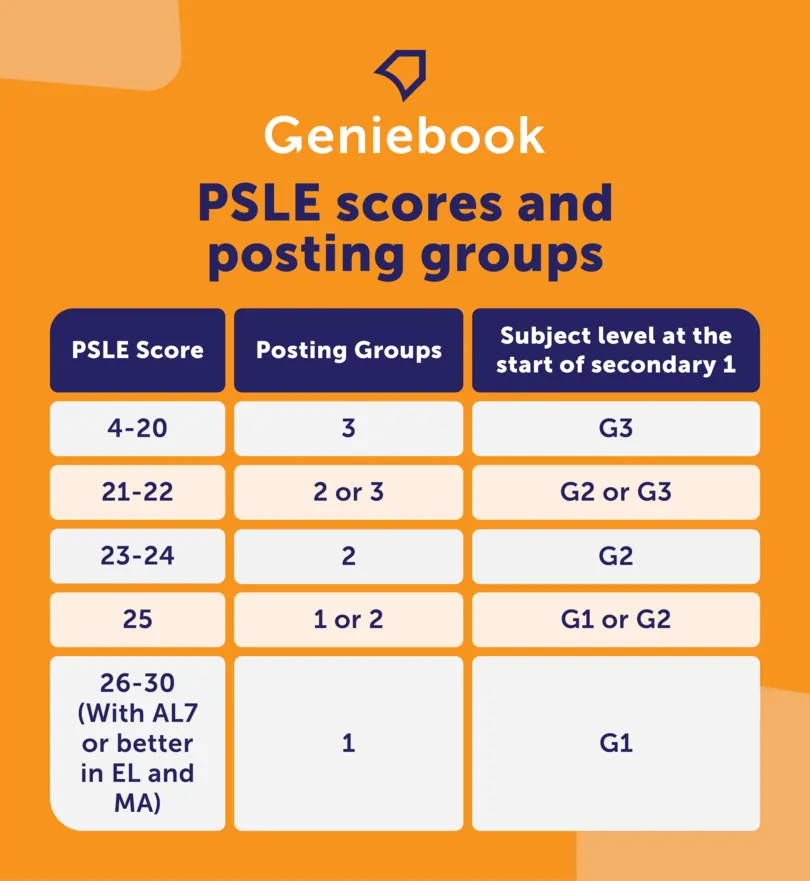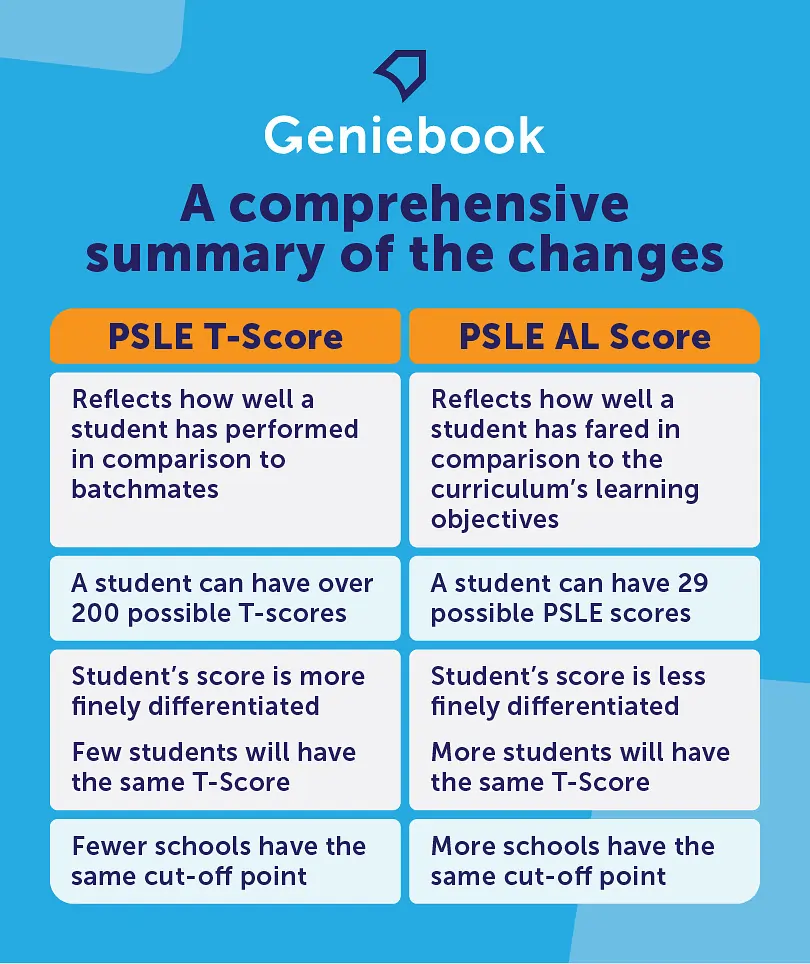PSLE 2025 Scoring System
*All information is accurate as of 16 January 2025.
Understanding the PSLE scoring system
The Ministry of Education (MOE) Singapore revised the PSLE Scoring system, effective from 2021.
Students are now graded based on 'Achievement Levels (ALs)' instead of 'T-Scores'. This change in the scoring system helps Primary 6 students focus on their strengths and weaknesses. It also provides them with more options for selecting secondary schools.
To find out your child's expected PSLE score, simply key in their expected score for each of the four subjects into our PSLE Score Calculator!
PSLE T-score vs PSLE AL score
The main difference between the old and new PSLE scoring systems is that the old T-Score system focused on exact marks, while the new AL system groups the student's marks into broader levels. This reduces pressure on students to stop aiming for specific high scores and helps them focus on their own learning and growth.
Let us explain this in detail:
T-Score grading meant that students missed getting their choice of school or courses by a few marks as there were 200 different scores. However, the new PSLE AL scoring system reduces the differentiation in students’ scores, cutting the range of possible PSLE scores to just 29 different scores (4 to 32, with 4 being the best). This means that more students will have the same PSLE scores and their chances of getting into their preferred secondary school increases.
Allow us to simplify this further with an example:
Suppose Tim secured 270 and Jim got a score of 275. The comparison between the two under T-Score grading would have been much more conspicuous. However, under the new AL grading system, Tim and Jim would both get a score of 4, thereby equalising their chances of getting into a school of their choice.
The new PSLE Scoring system also means that more schools have the same cut-off point. It affords the students a wider range of schools to choose from. Students can now consider not just from an academic standpoint but also strengths, interests, unique school programmes, culture fit, co-curricular activities, etc to continue their next stage of education.
Refer to the table below for a comprehensive summary of the changes:
PSLE scoring bands
Under the PSLE AL scoring system, there are 8 different PSLE scoring bands that are awarded for all standard PSLE subjects. The scoring range for each PSLE standard subject is as follows:

If you notice, AL6 and AL7 have a wider mark range than the other bands. MOE reassures that the AL bands reflect the way the curriculum and examinations are designed, where the levels of understanding are not linear. The ALs reflect the reality of learning, where each band reflects a level of understanding of a certain subject. Additionally, it is an indication of the student’s readiness level for the next course of study.
How the new PSLE AL scores are calculated?
With the AL scoring system, a student’s PSLE Score will be the sum of the four subjects added together. It can range from 4 to 32, with 4 being the best possible score. Below is an example of how a student’s PSLE Score is calculated:
| Subject | Score |
|---|---|
| English Language | AL2 |
| Mother Tongue Language | AL3 |
| Mathematics | AL1 |
| Science | AL1 |
| \(\begin{align}\small \text{Overall PSLE Score} &= 2 + 3 + 1 + 1\\[2ex] &= 7 \end{align}\) | |
From 2024, students will be posted to secondary school through three 'Posting Groups' - Posting groups 1, 2, and 3. Those who are not eligible for any courses will be offered the option of retaking the PSLE.
What are posting groups and how do they affect your child's subject levels?
Your child's posting group, which depends on their PSLE Score, determines whether they've been placed in secondary school through Posting Group 1, 2, or 3. In school, they'll have classmates from different posting groups, each with unique backgrounds, strengths, and interests.
Your child's posting group also influences the initial subject levels they'll take in secondary 1. For instance, if they're in posting group 1, their subjects will mostly be at G1 level. Posting Group 2 students will typically have subjects at G2 level, and so forth. However, their subject levels may change throughout their secondary school journey.
| Posting Group | Subject level |
|---|---|
| Posting group 1 | Mostly G1 Subjects |
| Posting group 2 | Mostly G2 Subjects |
| Posting group 3 | Mostly G3 Subjects |
Alternatively, students can also opt for the Assumption Pathway School (APS) or NorthLight School (NLS) for a more experiential and hands-on learning approach. Opting for these courses, however, requires the principal’s endorsement.
How does the PSLE score determine the posting group?
In secondary school, students can choose subjects at three levels: G1, G2, and G3 (where G stands for General). These levels replace the previous N(T), N(A), and Express standards. Students can change their subject levels when needed, depending on their strengths, interests, and learning needs. Later on, their subject choices and levels will determine the programs and paths available to them after secondary school.

Indicative achievement level cut-off points
Also known as AL COP, the cut-offs for different school types will be based on the previous year's cohort’s PSLE results and school choices. Let us see how it works: MOE will take the lowest and the highest indicative AL COPs of schools within each school type like government and aided schools, autonomous and independent schools, to find the range of indicative AL COPs based on the score of the last student admitted.
Remember, the AL COP may change every year depending on the PSLE results and school choice patterns. MOE encourages parents to choose schools wisely — not just academically but also:
- Consider the school environment
- Tally the child’s interests/aspirations with that of the school
- Proximity to residence
Parents are also encouraged to research each school’s programmes such as Co-Curricular Activities (CCA), Learning for Life Programme (LLP) and Applied Learning Programme (ALP). The ranking of their choice of schools will be used as a tie-breaker in case two students have the same PSLE score and are vying for the last available seat in a school.
For example, a student who placed ABC Secondary School as 1st choice will be given priority over another student who placed ABC Secondary School as 2nd choice even though both of them have the same PSLE score.
Prepare Your Child for PSLE Excellence with Engaging Lessons at Geniebook CAMPUS
PSLE now emphasises on students’’ mastery of concepts and ability to apply critical thinking over. At Geniebook CAMPUS, our engaging and structured lessons are thoughtfully designed to help students strengthen their concept clarity across all subjects.
By focusing on deeper understanding and critical thinking skills, these lessons equip your child to excel under the (AL) framework, giving them the confidence to tackle every PSLE challenge head-on.
Discover the difference at Geniebook CAMPUS!
Related Articles:
Frequently Asked Questions (FAQ)
Q1. What are AL scores in the PSLE?
AL scores refer to the Aggregate Scores of the PSLE. It is the total score achieved by adding up the scores for the four subjects in the PSLE.
Q2. Why are AL scores important?
AL scores are important as they are used by secondary schools to determine the eligibility of students for admission. The higher the AL score, the more choices of secondary schools the student will have.
Q3. When are PSLE results released?
PSLE results are typically released in November or December, around six weeks after the exams are taken. The exact release date is announced by the Ministry of Education each year.
 SG
SG  VN
VN 















